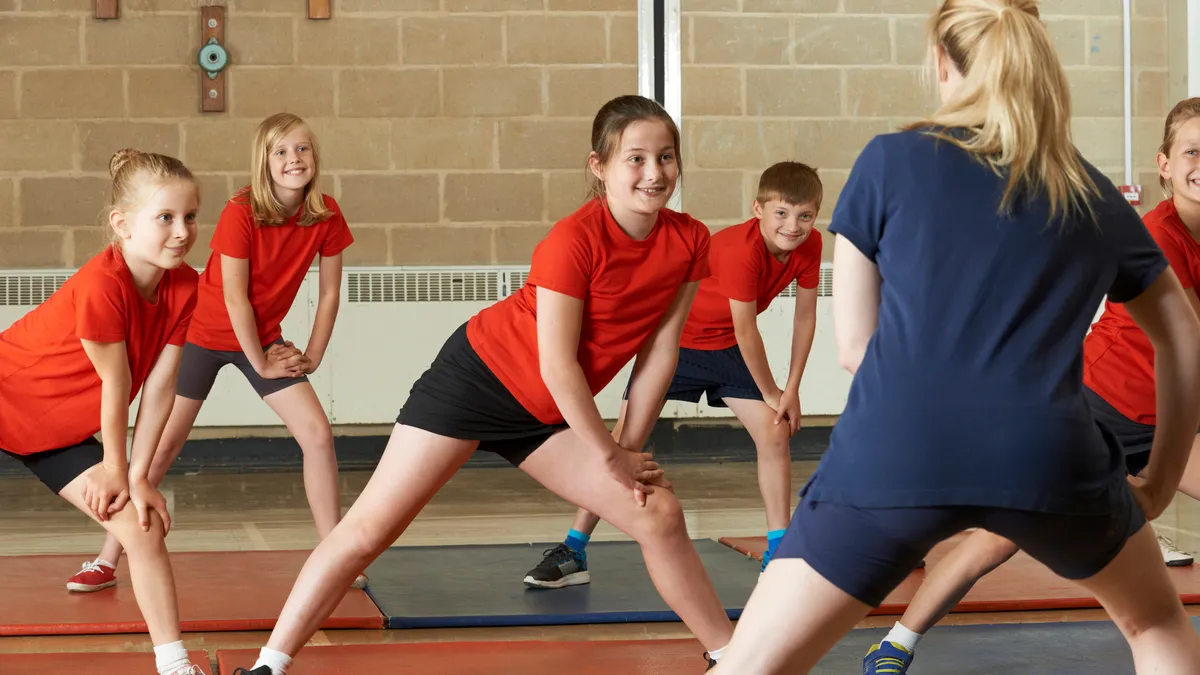When leaders of the Greece Central School District near Rochester, NY, began taking a closer look at their graduation data, they noticed that the reason many students weren’t meeting the requirements was because they were missing their physical education (PE) credit.
They took the issue to students on the district’s wellness committee and learned that the reason students weren’t passing was because they were refusing to change into PE clothes. Many were uncomfortable changing in the locker rooms and some just wore their PE uniforms under their regular clothes to avoid undressing.
“That’s what drove us to give kids options,” says Superintendent Kathleen Graupman.
Now students can choose whether or not to change for PE — a policy that, while certainly welcome for those who dreaded “dressing out,” is just one example of how the district has worked to give students input into what happens at school. Another recent change took place at Arcadia High School, where students were asked the question, “How do you want to start your day?”
In response, they have worked with teachers and other adults in the building to create 13-minute periods every morning based on different interests, such as a mindfulness session led by an art teacher, a game-playing session or another group focusing on young women as leaders. Like mini-advisory periods, the new twist on homeroom is meant to foster relationships between students and adults based on something they have in common. “The biggest thing is letting go and allowing kids to lead,” Graupman says. “You have to trust that.”
Giving students input into their school experiences has often been limited to narrow topics, such as voting on lunch menu options or organizing fundraising activities for an extracurricular program. In addition, those avenues for participation have often attracted the same motivated, outgoing and typically higher-achieving students. But those opportunities might not always attract less-outgoing students or those who already feel disengaged in school. Some district and school leaders, however, are now creating new structures to give students a voice not only into what might be considered “student life” issues, but also into school improvement and curriculum decisions.
It’s what Adam Fletcher, who founded SoundOut — a nonprofit organization that works with schools to increase student voice — calls meaningful student involvement.
“Students have all this voice already; it’s a matter of whether adults want to hear it,” he says. “What happens when we engage them as researchers, evaluators and decisionmakers?”
One answer is that they might just want to be involved in hiring their teachers. That’s what happened at Alcott College Prep in Chicago, one of 60 high schools to add student voice committees as part of the Chicago Public Schools’ civic engagement initiative. Thirty of the district’s elementary schools, most of which are grades K-8, also have the committees, which tend to meet after school with an adult facilitator and focus on researching issues, understanding root causes, considering all perspectives and learning how to best prepare proposals to take to their administrators.
“We really kind of encourage them not to think of them as student councils,” says Jessica Marshall, the director of social science and civic engagement for CPS. “We try to think a little more broadly about what student leadership means.”
Other issues the committees have tackled have included incentives for daily attendance, stocking girls’ restrooms with feminine products and planning school pride events to improve perceptions of a school within its local community. One committee succeeded at getting administrators to drop the school’s uniform policy, but students also learn that there are requests that might be unrealistic — such as off-campus lunch. “There’s a lot of learning and failure,” Marshall says, “but we don’t see administrators just shutting students down.”
Creating a ‘culture shift’
While not all students can participate in such a committee, they can all take a survey, which is another method schools are increasingly using to capture student perceptions, identify trends and decide which issues need attention.
“We believe that hearing from every single student matters for better data, but it’s also saying to every single student your voice matters. That starts to create a culture shift,” says Sonya Heisters, the director of partnerships for YouthTruth Student Survey, which was developed in 2008 and now captures responses from over 620,000 students in 34 states.
YouthTruth’s core survey covers a variety of school experiences, such as student engagement, academic rigor, bullying, college and career readiness and dropout risk factors. Another instrument can be linked to individual classrooms and is used to provide feedback to teachers. Districts can also customize surveys by adding questions that focus on local concerns. Schools can compare their results to others across the district, state or country, or look within their own schools to see how specific groups or grade levels answered the questions. Bullying data released by YouthTruth in September, for example, showed that students said they were most often bullied for their appearance and that most still experience bullying in person, in spite of increasing attention to cyberbullying in recent years.
The organization also provides workshops for schools to help them better understand and make use of their results. In California, some districts are using the surveys as part of the process of developing Local Control Accountability Plans (LCAP), a school funding system that requires student, family and community input.
“The LCAP process requires us to formally include parents in our planning processes, and YouthTruth has the potential to help us get more useful feedback from our parents,” says Ben Daley, chief academic officer for High Tech High Graduate School of Education, which has 13 schools in the San Diego area. “One of our LCAP goals this year is to make more meaningful use of student, staff, and parent survey data, because it's relatively easy to send out a survey and it's harder to make the time to make good use of the data.”
He adds that district leaders have recently been focusing on math instruction and are examining the data for attitudes from students that might lead them to say things like, "I'm not a math person."
“There are several questions in the YouthTruth survey that get at students’ sense of belonging in our academic community, which we hope help us know if we are on the right track,” he says.
In addition to sharing results with teachers and parents, Heisters says one of the best ways to encourage students to participate in surveys — and for administrators to demonstrate that they want students’ input — is to discuss the results with students.
“One of the most powerful things that can happen is closing the feedback loop with kids,” she says. “Here’s the data; this is what you told us.”
Student-led curriculum
Given the opportunity, students are likely to have some strong opinions about what they want to learn and what they find engaging in a class. That’s what Sally Brothers, an English teacher at Arcadia High in the Greece Central district, learned when she involved students in commemorating the 25th anniversary of the National African-American Read-In, organized by the Black Caucus of the National Council of Teachers of English.
The students brought poems written by family members, performed interpretive dance, read from biographies, and talked about books they were reading. Students enjoyed the experience so much, they expressed that they wished it was a class. So Brothers worked with them after school to design a credit-bearing, 12th grade English course that would win the district’s approval and reflect the experiences of other marginalized populations as well. Called Mosaics and focusing on cultural studies, current events and community service, the course is an optional 12th grade English class but also exists as a club for 9th-12th graders so that any student can participate in planning activities or events. The other three high schools in the district also have Mosaics, one other school has the course, and other districts are interested in implementing a similar program. The students help to drive the curriculum and decide what field trips they want to take while Brothers makes sure the content is aligned to the Common Core standards.
Mosaics “was designed by students who wanted to have a course where they could be in charge of their learning,” Brothers says. “This course will have similar qualities everywhere it exists, but none will be exactly alike because the curriculum is driven continuously throughout the year by students.”
Kidest Yigezu, a junior at Arcadia, is currently in the Mosaics club and says she “can’t wait” to be part of the course. “When I first joined [the club], I was more like a follower. I expected the teachers to tell me everything to do,” she says. But Mosaics has “helped me grow and be more of a leader.”
Anthony McCall, a 12th grader in the class and the club at Arcadia, says activities so far this year have included a field trip to a public market to learn about the history and the cultures represented, as well as discussions over issues such as not standing for the Pledge of Allegiance. He says it can take students awhile to get used to a class that is "unstructured and structured at the same time," and that it's important to have teachers or other adults who are comfortable enough "sit back and watch and talk when they need to."
Giving students more opportunities to influence decisions affecting their school can also help them become more engaged in their communities outside of school, according to the Civics Education Initiative, a Joe Foss Institute campaign to get states to make civic education a more prominent part of the curriculum. “Student participation in school governance” is listed as one of the proven practices for increasing the effectiveness of civic education in a report updating the initiative released in September.
James Wellemeyer, a senior at the Lawrenceville School in New Jersey, is one example of how participation in decisions affecting students contributed to broader civic awareness and involvement. A recipient of the school’s Welles Grant, which gives students a stipend to complete a summer project, Wellemeyer spent his time creating a 150-page e-textbook on youth involvement in politics. Titled "Youth Voices," the book “centers on student narratives to inspire students and, ultimately, hopes to interest, not bore, its users,” he says.
In addition to encouraging students to get involved in politics, the school’s administrators “always seek student input before making a significant decision,” he says. “My school polled students about workload and reduced weekend homework as a result.”
In the Greece Central School District, Graupman says district and school leaders are also more mindful of whether the students speaking before the school board or participating on school improvement committees are truly representing the district, demographically and socioeconomically. Principals now invite students for those types of opportunities that likely would not have volunteered or been chosen in the past. An emphasis on student voice is also reflected in the district’s strategic plan. Under each goal, there is the statement, “We know we are on the right track when students say …”
Marshall in Chicago adds that adjustments are to be expected when implementing a student voice initiative and that building support among teachers and school leaders is a “continuous process.” For example, she said her team learned that it was helpful for teachers, not just other school staff members, to work as the youth voice committee facilitators so that teachers could also learn positive ways to encourage the students’ participation.
“We want a student voice committee in every building,” she says. “You’ve got to give [students] practice and space so that they are leaders now, not just in some far off, distant future.”























